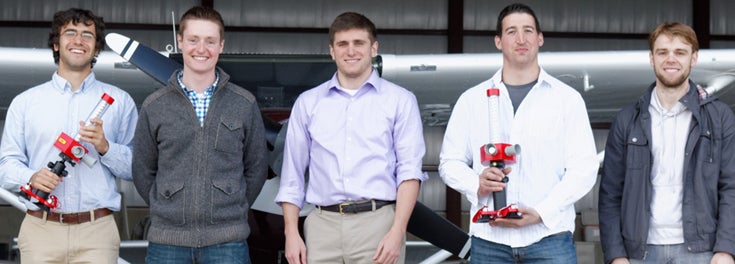
National championships aren’t just for athletics. Last spring, University of Rhode Island students won national championships in intelligent car design, soil judging, and security innovations. And now we’ve got one more. Our newest national championship was captured by a team of engineering students who beat out students from across the country in a Federal Aviation Administration competition to design technologies to improve airport operations.
The students invented a collision avoidance device that temporarily attaches to airplane wingtips and uses ultrasonic sensors to monitor the airport tarmac area as the aircraft is towed to the runway. The problem of wingtip collisions has long vexed the FAA, and since the students’ device is easy to use and quite affordable, there’s a good chance it might become a regular part of an airport near you.
Previous inventions from the capstone course have streamlined the manufacturing process at Toray Plastics, improved toys made by Hasbro, and helped many other Rhode Island companies.
Five recent graduates (pictured above) — industrial and systems engineering majors Christopher Clark and Lawrence Higgins, and mechanical engineering majors Kyle DellaGrotta, David Powers, and Ronald Wheeler — invented the device during their senior capstone course. The yearlong course requires students to solve a real-world problem with a viable product. The students studied the topic, sought advice from officials at the Rhode Island Airport Corp., built a prototype, and tested it at Quonset State Airport.
“Rather than just do work on campus, we were able to go out there, put it on a plane, and watch it in action,” said Lawrence. “That definitely made it better.”
The team traveled to Washington, D.C., in July to present their invention – coined The Wingman – to officials at the FAA, where it is already turning heads. It was the first time URI has won the FAA Design Competition, though URI teams also placed second and third in the last four years.
During the analysis and design process, the students explored the issue of wingtip collisions from every angle and proposed more than 150 solutions before settling on their final design. “It was a lot of solutions coming together,” David said. “We fixed the attachment problem one way, the detection problem in another way, and the audio problem in another way.”
The device is not the first URI student engineering project to attract attention. Previous inventions from the capstone course have streamlined the manufacturing process at Toray Plastics, improved toys made by Hasbro, and helped many other Rhode Island companies.
So if you’re looking to become a national champion, URI may be the place for you to come in for a landing.
In November, Rhode Island voters will be asked to support Question 4, a $125 million bond referendum for a new engineering building and upgrades to classrooms and labs to match the outstanding caliber of teaching, research, and innovation of the URI College of Engineering.
